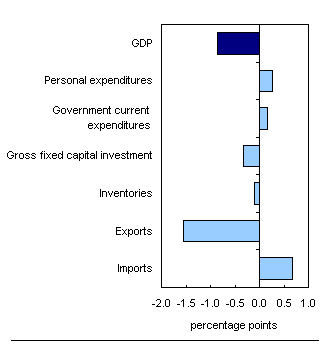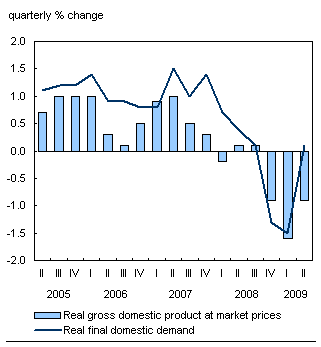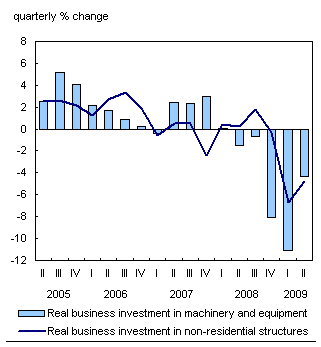Common menu bar links
Gross domestic product by income and by expenditure
Archived Content
Information identified as archived is provided for reference, research or recordkeeping purposes. It is not subject to the Government of Canada Web Standards and has not been altered or updated since it was archived. Please "contact us" to request a format other than those available.
Second quarter 2009
Gross domestic product by income and expenditure note to readers
Real gross domestic product (GDP) increased 0.1% in June, the first monthly increase since July 2008. For the second quarter as a whole real GDP decreased 0.9%, a less pronounced rate of decline than the 1.6% drop in the previous quarter. Final domestic demand increased 0.1% in the second quarter.
Chart B.1: Contributions to percent change in real gross domestic product (GDP), second quarter 2009
Description for Chart B.1

Increased purchases of motor vehicles pushed consumer spending higher in the second quarter, while a rebound in housing resales sparked activity in the residential real estate market. Exports of goods and services and business investment in machinery and equipment were both down, but not as sharply as in the first quarter.
The output of goods-producing industries continued to decline (-3.6%), with the manufacturing and energy sectors being the hardest hit. The service sector increased 0.3% following two consecutive quarterly declines, with the output of real estate agents and brokers contributing the most to the increase.
Chart B.2: Final domestic demand outpaces gross domestic product
Description for Chart B.2

Real GDP contracted at an annualized rate of 3.4% in the second quarter, compared with a 1.0% decline in the U.S. economy.
Table 1: Real gross domestic product, chained (2002) dollars
Consumer spending strengthens
Consumer spending on goods and services advanced 0.4%. Increased spending on durable goods (+1.5%), particularly motor vehicles, contributed to the second quarter gain. Increased spending on financial services, mostly on mutual funds and on stock and bond commissions, contributed to the growth in services (+0.4%).
Housing demand increases
Investment in residential structures increased 1.7% in the second quarter, halting five consecutive quarterly declines. Ownership transfer costs related to housing resale activity rebounded by 40%. This rebound offset a decline in the value of new housing construction. Renovation activity was also up (+2.2%) after weakening throughout most of 2008.
Decline in non-residential capital expenditure moderates
Businesses continued to reduce investment in buildings and engineering projects. However, the decline in engineering structures in the second quarter (-5.6%) was less pronounced than in the first quarter (-8.8%).
Investment fell in almost all categories of business machinery and equipment in the second quarter. Trucks and telecommunications equipment were the exceptions, as businesses increased their expenditures on both, following significant decreases in the previous two quarters. As a result, the 4.3% decline in expenditures on machinery and equipment was not as sharp as the 11% drop in the previous quarter.
Government investment in buildings and engineering projects increased 4.7%, the 11th consecutive quarterly advance.
Chart B.3: Decline in machinery equipment investment not as sharp
Description for Chart B.3

Inventories drawn down again
Inventories were drawn down substantially for a second consecutive quarter. Manufacturers, wholesalers, retailers and farmers all recorded lower inventories in the second quarter.
The economy-wide stock-to-sales ratio edged up to 0.79, equivalent to 72 days of sales, the highest since 1996.
Decline in imports eases
Imports fell 2.2% in the second quarter. This was the fourth quarterly decrease in a row, but was not as steep as in the previous two quarters. Machinery and equipment as well as industrial goods and materials were major contributors to the decline. On the other hand, small increases were recorded in automotive products, "other consumer goods," and agricultural and fish products.
Exports continue to fall
Exports of goods and services dropped 5.2% in the second quarter, after falling 8.7% in the first quarter. Most categories of goods declined, particularly machinery and equipment, industrial goods and materials, and energy products. Exports of services fell 0.3%, after declining substantially in the first quarter.
Economy-wide incomes down slightly
Nominal GDP decreased 0.6% in the quarter, a much slower decline than in the two previous quarters. Corporate profits fell 11%, the third consecutive quarterly double-digit decline. As in the previous two quarters, lower profits were recorded by energy, mining and financial industries. Labour income fell 0.5%. Business sector labour income declined 1.1%, while there was a 1.3% increase in government sector labour income.
Personal income edged up, after falling 0.9% in the first quarter, as Employment Insurance benefits increased 23%. Personal outlays were virtually unchanged from the first quarter, as a drop in personal income taxes helped offset an increase in personal expenditure on goods and services. The saving rate in the personal sector remained at 4.5%.
National saving rate falls again
The national saving rate was 4.4%, its lowest rate since 1994. Both personal and corporate saving rose slightly in the second quarter. Government sector saving (all levels combined) was down for a second consecutive quarter as government revenues continued to decline.
Purchasing power declines
Real gross domestic income (GDI), a measure of Canada's purchasing power, fell 0.5% in the second quarter. The drop in real GDI was less pronounced than the drop in real GDP, as Canada's quarterly terms of trade improved for the first time since the second quarter of 2008. Real GDI was down 8.2% from the second quarter of 2008.
Table 2: Real gross domestic income, colume index (2002=100)
Economy-wide prices increase for the first time in three quarters
The price of goods and services produced in Canada increased 0.3%, after declines in the two previous quarters. Excluding energy, prices increased 0.7%. The price of final domestic demand was unchanged.
Data tables
- Table B.1 Gross domestic product, income-based, current prices and quarterly percentage change
- Table B.2 Gross domestic product, expenditure-based, current prices and quarterly percentage change
- Table B.3 Real gross domestic product, expenditure-based, quarterly percentage change
- Table B.4 Real gross domestic product, expenditure-based, annualized percentage change
- Table B.5 Contributions to percentage change in real gross domestic product, expenditure-based
- Table B.6 Gross domestic product, implicit chain price indexes
Information on methods and data quality available in the Integrated Meta Data Base: 1901 and 2602.

